Looking for a new activity you can enjoy with your pup? Want to get you and your pooch some more exercise? Need a way to provide more stimulation and enrichment for your floof?
Boy, do we have the answer for you — it’s called canicross, and it’s becoming more and more popular for a reason.
Read on to learn all about this canine-and-human activity!
What is Canicross?
Canicross is the practice of running with your dog (aka canine cross country).
Canicross got started in Europe, where mushers began the practice to exercise with their dogs during the mushing off-season. Like other varieties of urban mushing, canicross has since grown to be a popular sport in its own right.
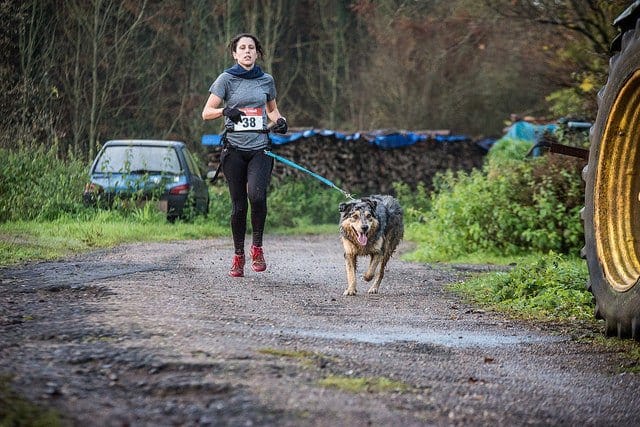
Canicross involves a dog (or sometimes two dogs) staying attached to a runner, with the runner wearing a waist belt with a bungee cord that attaches to the dog’s harness.
The elastic bungee cord reduces the pulling shock for humans and dogs, allowing them to run more comfortably together. A wide waist belt helps disperse the force of the dog’s pulling so that it’s comfy for the runner.
It’s basically an extreme version of running with your dog. Technically this sport requires the dogs to pull, but you absolutely can get started by simply jogging with your dogs and then move into the pulling aspect later.
Take a look at what canicross looks like in action!
Canicross races are generally 5k, but may be longer at 10k. This makes them quite a bit shorter than a traditional sled dog race (which is often 70 miles or more).
Recommended Read
Not quite ready for long distances? Read our guide on how to train your dog to run with you — it’s perfect for when you’re first setting out on your jogging journey with your furry pal!
Canicross Racing Dogs: What to Get if You Want to Compete
Nowadays, the most elite racing dogs seen in canicross are generally German Shorthaired Pointers and a mixed breed called a Eurohound.
These deep-chested, thin-coated dogs have the legs and lung capacity to run fast for 5k, 10k, or even further races. With long legs and thinner coats, they do better in the fast and warm races than Huskies, which are bred for multi-day endurance.
Eurohounds are most commonly mixed between Huskies and German Shorthaired Pointers, but racing dogs often have a bit of Greyhound thrown in. With such mixed heritage, it’s no surprise that Eurohounds don’t all look alike – each one is a bit different.
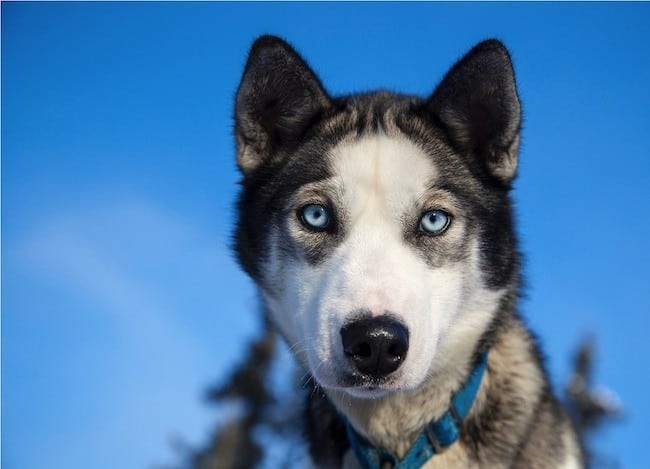
Breed or Mix Matters for Canicross
While all dogs can enjoy canicross, it will work differently depending on your dog’s breed and size. Smaller dogs won’t be able to provide as much pulling power, while large dogs will provide some serious assistance in giving you a bit of extra power .
Some dogs are just built to run longer distances than others. Simply make sure you understand what your dog is capable of, and stay within the limits of what makes sense for them.
Want to learn more about which dogs are best built for going the extra mile? Check out our list of the best dog breeds for running!
Are There Any Dogs That Can’t Do Canicross?
Keep in mind that ultra-small dogs, ultra-large dogs, and short-nosed (brachycephalic) dogs are all ill-suited to canicross.
Super small toy breeds simply won’t be able to keep up, and running is flat-out dangerous for short-nosed dogs like Boxers and Pugs. Giant breeds can damage their joints on runs.

While all breeds of dogs, from Labradors to Terriers, can participate in canicross, the dog’s personality plays an important role as well. Some dogs love to run, and they’ll go nuts over canicross.
Not all dogs love to run though, and those less inclined to bound about will probably not enjoy canicross. Don’t make your dog do something that they hate!
If you really want a jogging pal but own a couch potato dog, consider running with another owner’s dog through a dog walking app like Rover or Wag – you’ll get a running partner and earn some extra cash!
What’s especially unique about canicross is that a variety of humans can participate as well – children, disabled individuals, and the visually impaired can all enjoy canicross, with proper training and preparation.
Be sure to pick up a rescue harness — it’ll prove invaluable should your doggo get injured!
Canicross For Beginners: How to Get Started
Of course, canicross is about more than just bringing home the right dog. In order to get started with canicross, you need to:
- Work on the training commands. When your dog is running full-tilt and attached to your center of gravity, it’s important to be able to control his speed and direction through verbal commands.
- Build up physical strength for the race. Both you and your dog will need to do at least a bit of training to be ready for any races. Even if you just want to enjoy a weekend activity together, you’ll want to ensure that you’re physically fit enough for this at times taxing sport.
- Get the right equipment. While you certainly can go jogging with your dog on a handheld leash and any old back-clip harness, true canicross involves your dog pulling you. This means that you both need specialized equipment!
We’ll go over the best gear to grab further down. Let’s start off talking about what you should do before you pick up the leash.
Top Trick To Get Started: Find a Club
One of the best ways to get started in canicross is to find a local club. Many traditional running clubs don’t allow dogs, and even if they do, full-on canicross is a bit of a hassle if you’re trying to run with friends.
Canicross is much more common in Europe than in the U.S., but that doesn’t mean you can’t get involved with a club stateside! The Canicross USA Facebook page is a great resource with a very responsive messenger. You can also check their website at canicrossusa.com.
When I was looking for a race in San Diego but couldn’t find evidence of a club, I just messaged the Facebook page, not expecting much. I got a message back within an hour or two, and am now signed up for a 5k in two weeks!
The Learn Canicross Facebook Group is a very helpful group to get started and learn canicross if you’re not near a club.
Since canicross is still a bit new across much of the world, you might not find the [your city] Canicross Club. However, you can likely still find local dog-friendly races and connect with other dog-joggers at the events. Lindsay over at Run That Mutt has also created a great list collection of canicross races you can sign up for across the US.
Simply google “dog friendly races in [your city]” and you’re likely to find plenty of 5k races that allow dogs. Many are even fundraisers for local rescue groups!
The International Federation of Sleddog Sports is a great resource for international canicross races. That said, you can pretty much always just use the google method for finding clubs and races!
Now that we know what we need to get started and how to find clubs, let’s go over the basics of how to get started with canicross.
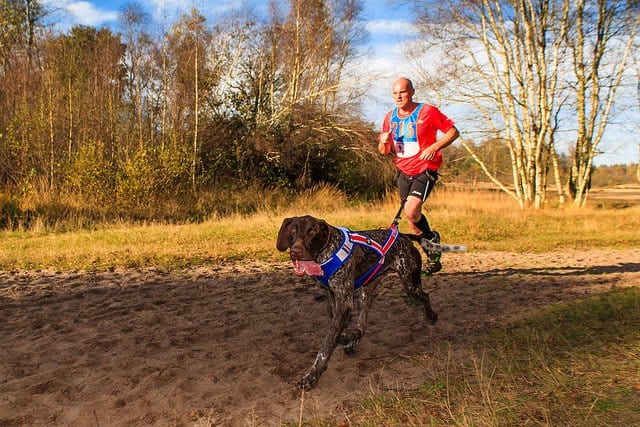
Does My Dog Need to Be Fit? Do I Need to Be Fit?
You can start canicross at any level of fitness. Just remember to start out easy and don’t push yourself or your dog too hard. Canicross can be performed while walking, hiking, or running.
You might want to start out with a basic “couch to 5k” plan for you and your dog. For most medium-sized dogs in good health (provided they’re not brachycephalic), a joint couch-to-5k plan will be perfect for getting your dog in shape.
If your dog is older or out of shape while you’re in decent shape, you can try just taking your dog on part of your runs at first. You can always do run-walk combo outings together!
Don’t expect your dog to become a champion runner overnight – and in fact, some will never become running pros. Start slow, work your way up, and watch your dog carefully to ensure you’re never pushing them too hard.
If you’re starting with a dog who hasn’t done much running, be sure to check out our guide on how to prep your dog for long-distance running. You definitely don’t want to just start running 10ks with your pooch without some prepping!
Canicross Training: An Introduction
While canicross doesn’t require ultra-specialized training, you’ll get the most out of it with some basic training practice.
1. Voice Commands
Canicross will go much smoother if you have some basic dog training down and if your dog can understand and respond to some verbal cues. These are the same verbal cues found with dog joring.
- Stop / Whoa. Tells your dog to stop moving.
- Hike / Hike On / Let’s Go / Lead / Pull. Tells your dog to get going!
- Wait / Stand. A reminder to your dog to stand still and not move forward.
- Hup Hup / Hike Hike / Quick Quick / Pick It Up. Tells your dog to go faster.
- Slow. Tells your dog to slow down.
- Leave it / Get On. Tells your dog to ignore a distraction and continue moving.
- Gee / Right. Tells your dog to move towards the right.
- Haw / Left. Tells your dog to move towards the left.
- Straight. Tells your dog to continue straight through intersections without turning.
- Yield. Move off the trail. This command is often used when another musher or individual is intersecting with you.
- On By. Go around an object. You can use this word along with the gee and haw commands to tell your dog which way to go around an object.
A quick note — you don’t even need all of these commands. I competed in my first canicross race with my own dog with just Hold Up (my version of stop), Easy (my version of slow), Hike, Wait, Left, Right, Leave It, and Straight.
We’ve found you can combine Leave It and On By pretty easily. We’ve never used Yield, but maybe that says something about my trail manners!
Bonus Canicross Commands
- Cross. Tells your dog to cross to the other side of the path.
- Abit. A slight turn. Combine with other commands. For example, Gee Abit means take a light right at the fork.
- Visit. Tells your dogs when it’s OK to interact with other dogs.
- Take A Break. Tells dogs to relax for a bit and calm down.
A big thanks to BikeJor.com for providing information on many of these commands. Check them out for more bonus commands.
When I started training for canicross and skijoring, I started teaching my dog Barley his commands during our daily walks.
Right before we turned left at a junction, I said “Haw.” When we paused at a crosswalk, I said “Wait.” If we were crossing a busy street, I practiced “Hup hup.”
When we started training to run together, Barley already knew the basic gist of the commands. He’d learned that the words predicted me moving in a given way, so he anticipated my movements by obeying the cues. It made everything much easier!
You can also teach your dog the commands using treats or toys by saying the cue, then tossing a treat in a given direction. This method might be faster at first, but can create an over-reliance on treats.
I almost always use treats for everything I do, but canicross skills were one exception where I mostly left the treats at home!
2. Teaching Your Dog to Pull
While pulling isn’t required for canicross, it is common, and is considered a major aspect of what differentiates canicross from simply running with your dog.
It can be a bit difficult to get your dog to pull, especially when they’ve been taught that pulling is bad.
Don’t worry – we aren’t going to destroy years of dog walking manners! You’ll make sure your dog understands the difference between walking and canicross by teaching them that different equipment calls for different attitudes.
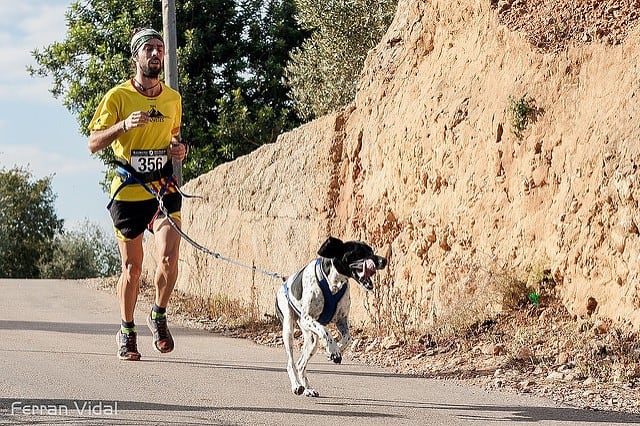
photo from Ferran, flickr
Show your dog that pulling should only be OK when he’s wearing the pulling harness and you’re wearing the hands-free leash – collars and traditional leashes are for walking only.
These special canicross harnesses are actually designed to help your dog pull, as they allow your dog to use the force of their chest to pull. A good pulling harness will also distribute the dog’s weight down his back and to his hips.
I walk my dog using a normal harness, and he doesn’t pull on that. He knows that the special pulling harness, plus my voice cues, are when it’s time to go fast!
When starting off with canicross, it’s often easiest to have a friend walk ahead of you and encourage your dog to walk and pull ahead of you. When they pull, be sure to give lots of praise and encouragement.
If you don’t have a dedicated training buddy, you can use this method I found really useful. I hooked Barley’s harness up to a fence and then stepped just out of reach. I held a couple treats and waited for Barley to lean into the harness. When he put enough pressure onto the harness, I fed a treat.
Gradually, I increased how hard and how long he had to pull in order to get the treat. I added a cue (Hike) and then started cuing him to Hike while I stood to his side.
Eventually, I moved behind him so that he was moving away from me (hard for many dogs) rather than towards me.
Usually a couple of canicross sessions a week are a good place to start. Once your dog gets the hang of it, the road is yours!
Canicross Gear: Harness, Belts, and Tow Lines
You’ll definitely want to make sure you’re equipped with the right canicross gear.
Letting your dog pull on a neck collar is dangerous for him, and let me tell you — running with an enthusiastic dog and a narrow waist leash hurts your back!
Do yourself and your dog a favor and get the right gear for the job. I personally use the Ruffwear Omnijore System and love it. You can also piece together a canicross starter kit using other products, but the Ruffwear Omnijore has it all in one easy kit.
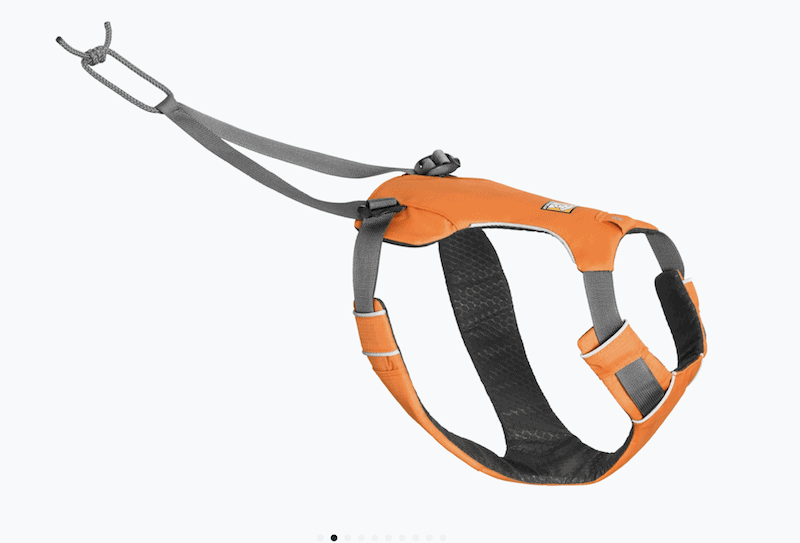
Just make sure you don’t run down to your nearest pet shop and buy the first harness and waist leash you see. A good canicross starter kit will include a comfy canicross belt that will protect your hip and a harness that’s specially designed to help your dog pull in comfort.
Whether you go with the Ruffwear Omnijore System above, or choose to put together your own canicross starter kit (we know the Ruffwear Omnijore kit is pricey and won’t work for everyone’s budgets), there are a few things to keep in mind. Be sure to get a setup that includes:
- A wide canicross belt that distributes the pulling force across your back and hips.
- A quick-release or emergency-release so that you can free yourself of your dog if needed. I used this feature once when I got really tangled during a tumble, and it made a bad situation a bit better!
- Pockets or water bottle holders if you’re going far distances. The Ruffwear Omnijore system includes both, making it easy to stash treats, citronella spray, and poop bags in one side, a water bottle in the back, and a phone or other piece of gear on the other side.
- A bungee leash to help absorb shock and encourage your dog to pull. Your dog will feel more comfortable pulling on it, and you’ll feel more comfortable pulling on it. This reduces any snapping in the leash that could happen if you crest a hill and the dog takes up slack quickly, for example.
- A harness that’s made for pulling. I can’t stress this enough. Don’t run canicross with a front-clip no-pull harness or a neck collar. Both are dangerous for your dog. Even a normal back-clip harness won’t cut it. A good canicross harness will really help your dog pull with comfort and ease, distributing weight across your dog’s back and hips rather than just his chest.
Let’s dig into why we need this specialized equipment a bit more because I know canicross starter kits aren’t cheap.
Canicross really can’t be performed with a regular leash and harness combo – it’s recommended that you get a dog joring system with a dog harness and human waist belt. Here’s why:
- Using a collar and leash could injure your dog. If your dog pulls hard with a classic throat collar, they could easily hurt themselves. A specialized harness lets your dog pull safely without breathing restriction.
- A harness helps dogs distinguish when to pull and when to walk nicely. Using a leash and collar for canicross is also very confusing for dogs – they will have a harder time distinguishing when to pull with canicross and when to heel with regular walking. Harnesses feel very different than collars for dogs, and using them for different activities helps teach a dog that a harness is meant for pulling while a collar is meant for walking.
- The bungee cord absorbs shock. In canicross, the human wears a waist belt that attached to a dog’s harness with a bungee or elastic cord. This pliable cord absorbs pulling shock, helping owner and dog run together without being jolted all over.
Though you absolutely can get started with canicross using just the Omnijore system, I pack a few other things when I’m heading out with my dog.
Some other good equipment to have in your trunk or in your pockets includes:
- Musher’s Secret Paw Wax. This stuff is amazing. Musher’s Wax is a paw salve that helps protect your pup’s paws from cracking and other wear-and-tear. A must have, especially if you don’t run your dog in boots.
- Dog Booties (Optional). I don’t use dog boots, but you may choose to use those instead of Musher’s Wax to protect your pooch’s paws.
- Gauze and tape. I keep this in my car in case Barley tears a nail on a run. He’s only cut himself running once, but there was quite a bit of blood! I was really glad to have some gauze and tape to patch him up since he actually ended up needing staples later on.
- Treats. It’s never a bad idea to tuck a few cookies into your canicross belt. I personally carry Temptations Cat Treats these days (they don’t go bad as quickly as many other similarly tasty treats, and they’re cheap), but there are all sorts of excellent training treats out there!
- Citronella Spray. It sucks to think that so many people let their unfriendly dogs run amok off-leash, but it’s a sad reality on trails. The Spray Shield citronella spray is a safe way to keep off-leash and potentially aggressive dogs away if necessary. It’s far kinder to use on an oncoming dog than pepper spray or more heavy duty dog repellent sprays, so I carry it instead.
- Sunscreen and chapstick. This isn’t for your dog – it’s for you! A small tube of sunscreen and some chapstick fits nicely into the pockets of most canicross belts and will make your long runs much more pleasant!
It sounds like a lot of gear, but it all fits nicely into most belts. Don’t forget your water and your poop bags!
Advantages of Canicross
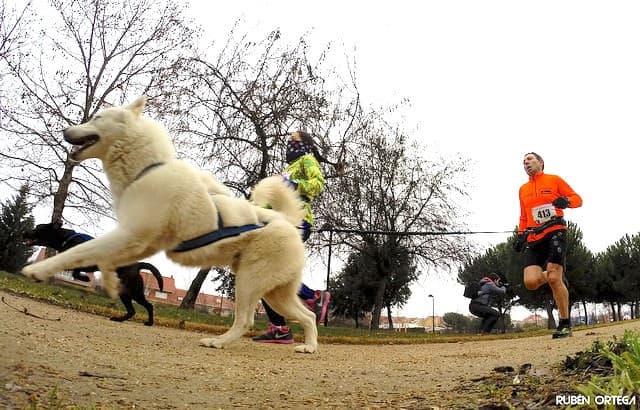
photo from Rubén Ortega Vega, flickr
Canicross is hugely beneficial for you and your dog. Here are some reasons why.
- It’s a great source of exercise. Canicross is a great source of exercise for both humans and canines.
- It will strengthen your relationship. Canicross helps strengthen the bond between pet and owner, especially when both are working hard together as a team.
- Canicross can open up a whole new world. Many cities have canicross groups and events where you can meet other dogs and runners. It’s a great way to make new friends!
- Canicross has a low barrier to entry. Unlike many other dog sports, canicross is also easy to do anytime, anywhere. You don’t need a whole agility setup and you don’t have to drive to the sheep farm for herding. You can simply get a canicross starter kit for under $200 and hit the trails out your back door!
It seems like many people start canicross for the exercise, but they stay because of the bond it builds with their dog. There’s nothing like a wagging tail and a lolling tongue to make running more fun!
Last Pieces of Canicross Advice
Before you hit the trails, there are a few things to keep in mind. It’s important to be safe and have fun on your runs. Here are a few pieces of advice to remember with canicross.
- No Dogs Under One Year. Canicross shouldn’t be performed with dogs under one year old. Their bodies are still forming and adding physical stress at a young age could hurt them and cause bigger issues as they get older. Some giant breed dogs mature even more slowly and shouldn’t run until they’re closer to 18 months or two years old.
- Pick Your Trails Wisely. Avoid running with your dog on concrete or pavement too much. Stick to gravel or soft forest trails whenever you can. This will feel better on your knees, too! Be sure to obey local laws regarding dogs on trails, too. Not all trails allow dogs, especially those in national parks or that are catered towards cyclists.
- Consult Your Vet First. It’s always advised to contact your vet before beginning canicross, just to get the OK from them and ensure your dog can safely participate. Better safe than sorry.
- Don’t Canicross When It’s Hot. Heat can be very dangerous, especially for dogs. Never run in the heat of the day or when it’s excessively hot. When it’s warm, be sure to keep an eye on your dog and watch out for dehydration. Huskies and other thick-coated dogs might not even want to run until it’s under 60 degrees. Remember that you’re not wearing the same thick fur coat as you dog is!
- Hydrate Before Running. Both you and your dog should always hydrate before canicross. Keep water and Pedialyte on hand in case your dog begins to suffer from dehydration and needs a boost!
- Be Patient. It may take your dog some time to get adjusted to canicross. Take your time and don’t rush things! Start out slow and build your way up.
Canicross can be a rewarding sport for owners and dogs, but it won’t be for everyone. For one, not owners want to get into the habit of encouraging their dogs to pull – especially if you’ve just broken them of that habit!
For some folks, some sneakers and a good dog harness designed for running is all you really want – you don’t need to dive into the canicross sport to simply enjoy jogging with your four-footed pal!
Love Canicrsoss? Try This Too!
I love running — I just ran my second marathon and run almost every day. But sometimes, the weather or my knees just aren’t up for it. Other times, it’s fun to really see my dog run as fast as he wants, not lugging behind my slow two feet.
Last winter, Barley and I really took a deep dive into the different varieties of urban mushing.
We tried skijoring, scootering, and bikejoring. Whether you’re in a snowy winter wonderland or a warmer part of the country, you don’t have to stick to canicross if you like adventuring with your dog.
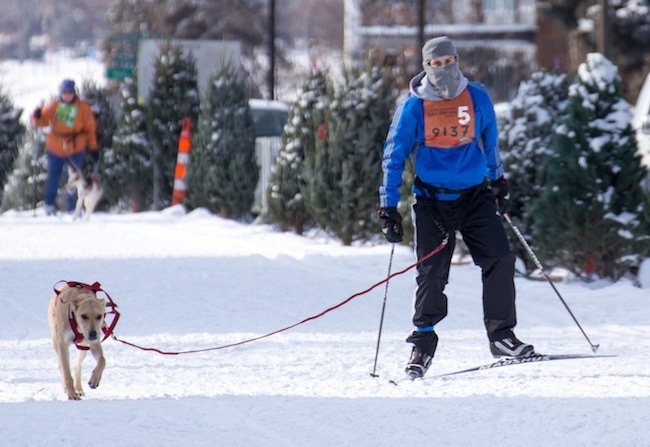
Most other sports that involve teaching your dog to pull you also involve wheels. This means they’re faster and, in my opinion, a bit scarier. Each subset of urban mushing involves your dog pulling you using a specialized harness. What changes is what you’re using to hold the human!
That said, you might not just want to try different pulling sports. What if you just love training and adventuring with your dog?
If you like canicross but aren’t ready for a scary wheeled pulling sport, you might want to try:
- Treibball. This sport is perfect for those zany herding breeds like Corgis and Collies, but any dog can excel. Based on herding sheep (but more suitable for urban environments), this sport involves teaching dogs to nose or paw exercise balls into a goal by following their owner’s cues. Treibball is timed and requires a high level of training, posing a worthy challenge for dog and owner alike.
- Truffle hunting. I love scent sports (where a dog sniffs out a hidden scent in a timed event), but truffle hunting is probably even cooler. Rather than paying money to enter expensive trials, your dog sniffs out high-value truffles for you! While this activity takes quite a bit of nosework training early on, you will ultimately be able to take your dog for hikes to find truffles.
- Agility. This fast-paced sport is incredibly popular for good reason. It’s a great workout for you and your dog (have you noticed how handlers sprint through the field alongside their dogs?). Here, dogs navigate a timed obstacle course. Like Treibball, this sport is very training-heavy and can be tricky to get started with.
Of course, there are many more ways to get out and exercise with your dog. Check out our list of 22 games to play with your dog to see a list of our favorites.
Have you ever done canicross? What about just regular running with your dog? What has your experience been like? Share your thoughts in the comments!
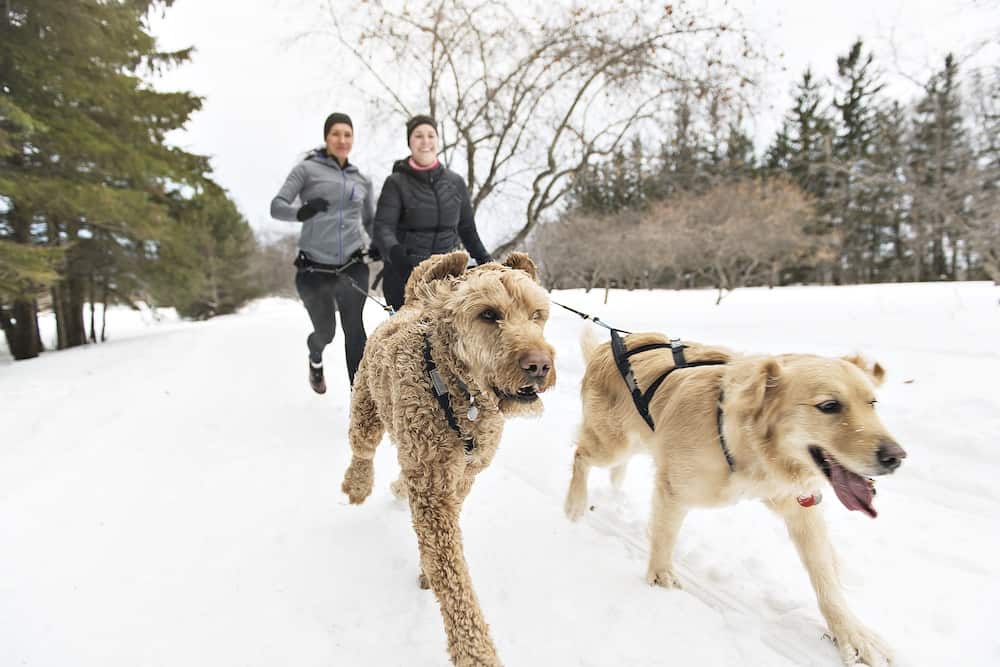



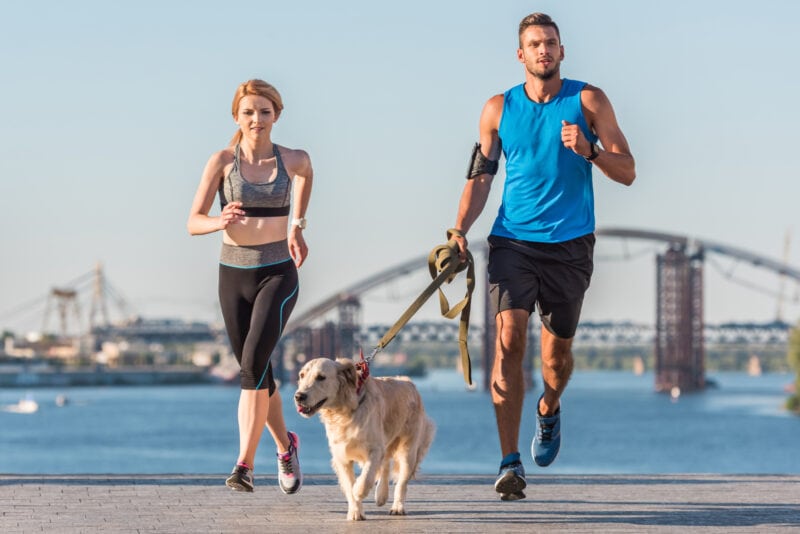
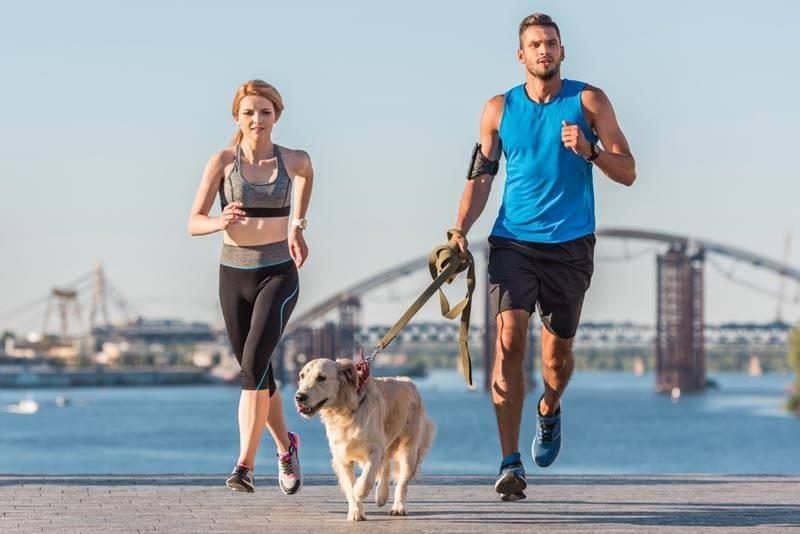
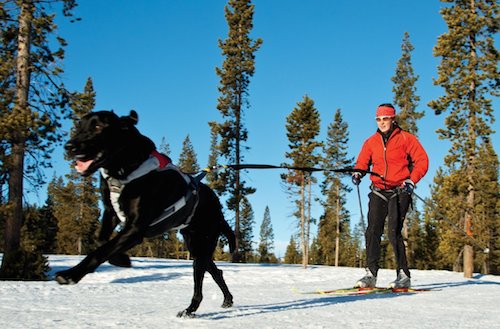

Leave a Comment